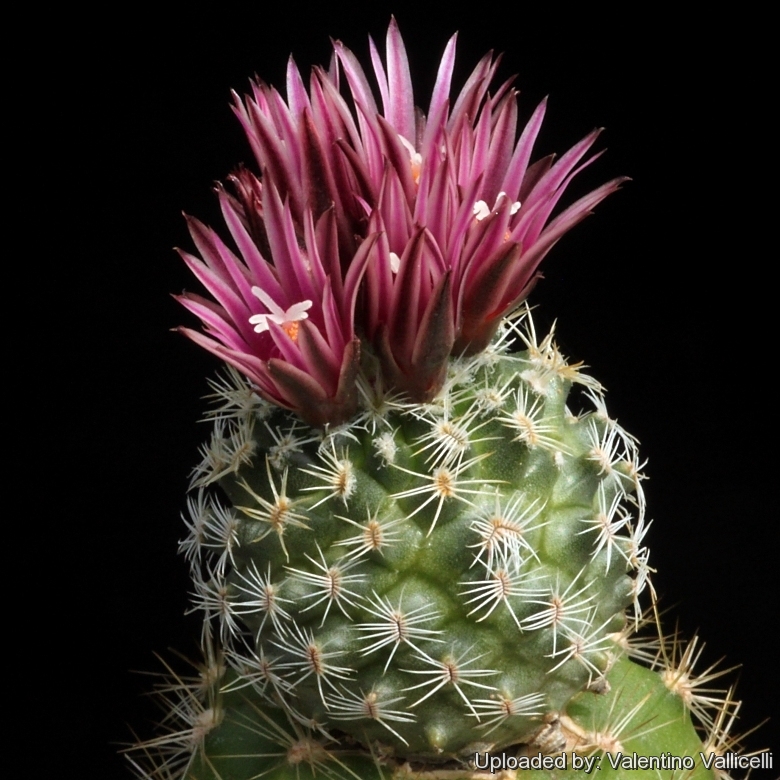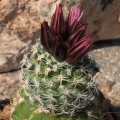
Pelecyphora hybrid aselliformis x Turbinicarpus sphacelatus Photo by: Valentino Vallicelli
Origin and Habitat: Garden origin (Nursery produced hybrid)
Synonyms:
Description: It is a small slow growing clustering cactus obtained by crossing ♀ Pelecyphora aselliformisSN|855]]SN|855]] x ♂ Turbinicarpus sphacelatusSN|17786]]SN|17786]]. The superb features of this rare plant are due to the intersection between the traits of the ancestors. It has inherited by Pelecyphora aselliformisSN|855]]SN|855]] the laterally flattened tubercles and the pectinate spines, but spines are longer. The flower are also very beautiful and reminds those of the Turbinicarpus sphacelatusSN|17786]]SN|17786]].
Stem: Spherical to shortly cylindrical, 5-10 cm tall, up to 5 cm in diameter.
Tubercles: Laterally flattened, elongated, arranged in spirals;
Areoles: Oval shaped, brown, with scarce white wool when young but becoming soon bare as they ages.
Spines: 15-10 pectinate, subulate creamy or greys with a brownish base and sligltly darker tips.
Flowers: Pink to violet flowers with lighter outside petals, 2 - 3.5 cm in diameter. The floral buds are acuminate and appear on the apex.
Fruit: Not known
Blooming season: It normally flowers from February till November in several flushes, but only if the sunlight is strong enough.
 Pelecyphora hybrid aselliformis x Turbinicarpus sphacelatus Photo by: Valentino Vallicelli
Pelecyphora hybrid aselliformis x Turbinicarpus sphacelatus Photo by: Valentino Vallicelli Pelecyphora hybrid aselliformis x Turbinicarpus sphacelatus Photo by: Valentino Vallicelli
Pelecyphora hybrid aselliformis x Turbinicarpus sphacelatus Photo by: Valentino Vallicelli Pelecyphora hybrid aselliformis x Turbinicarpus sphacelatus Photo by: Valentino Vallicelli
Pelecyphora hybrid aselliformis x Turbinicarpus sphacelatus Photo by: Valentino Vallicelli Pelecyphora hybrid aselliformis x Turbinicarpus sphacelatus Photo by: Valentino Vallicelli
Pelecyphora hybrid aselliformis x Turbinicarpus sphacelatus Photo by: Valentino Vallicelli Pelecyphora hybrid aselliformis x Turbinicarpus sphacelatus Photo by: Valentino Vallicelli
Pelecyphora hybrid aselliformis x Turbinicarpus sphacelatus Photo by: Valentino Vallicelli Pelecyphora hybrid aselliformis x Turbinicarpus sphacelatus Photo by: Valentino Vallicelli
Pelecyphora hybrid aselliformis x Turbinicarpus sphacelatus Photo by: Valentino Vallicelli Pelecyphora hybrid aselliformis x Turbinicarpus sphacelatus Photo by: Valentino Vallicelli
Pelecyphora hybrid aselliformis x Turbinicarpus sphacelatus Photo by: Valentino Vallicelli Pelecyphora hybrid aselliformis x Turbinicarpus sphacelatus Photo by: Valentino Vallicelli
Pelecyphora hybrid aselliformis x Turbinicarpus sphacelatus Photo by: Valentino VallicelliCultivation and Propagation: It’s a relatively easy species to cultivate, but very slow growing. Needs a very well drained soil. Requires strong sun to part sun to develop good spinal growth and waterings should be rather infrequent, to keep the plant compact and not become excessively elongated and unnatural in appearance. Keep dry in winter, or when night temperatures remain below 10° C (but some people give this plant a light monthly watering to prevent the drying and shedding of the lower tubercles.) it is hardy to -4°C for a short period. Assure a good ventilation.
Propagation: It can be reproduced both by seeds, but it is often grafted because difficult and slow to grow on its own roots. Older specimens shoot tillers from under tubercles, so they can be grafted, which is a much easier way of propagation than sowing. Young seedlings are tiny and they need several years to reach adult size, and require very careful watering.
Your Photos

by Valentino Vallicelli



















